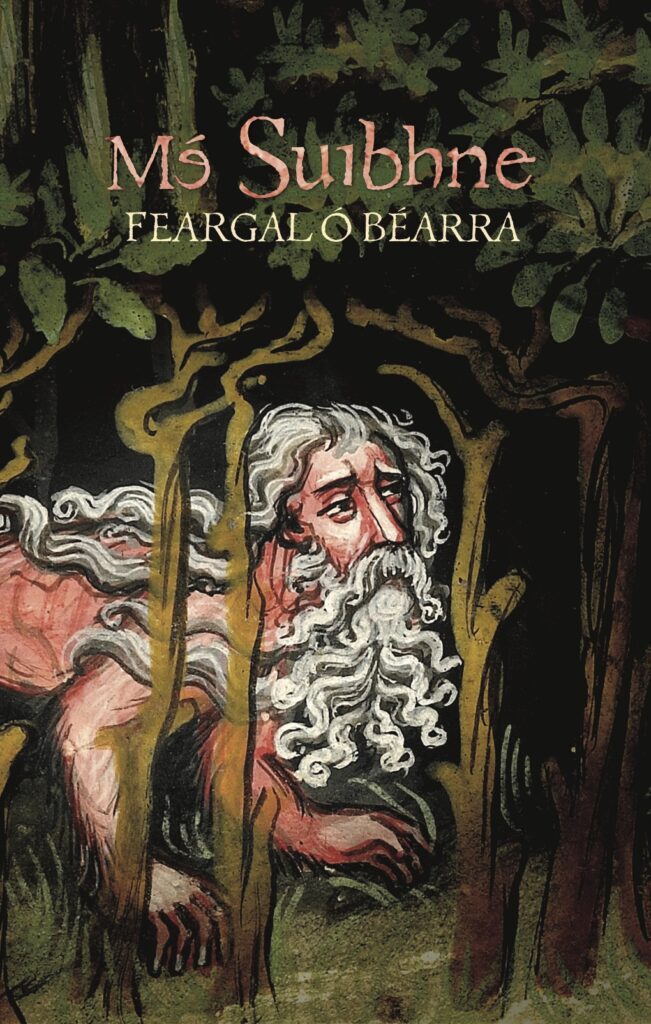
Mé Suibhne|Feargal Ó Béarra|Leabhar Breac|ISBN 978-1-913814-08-3|€16.00
“Ó Béarra’s knowledge of the text and the tradition from which it comes allow him to rework the original with sympathy and authority.”—Cathal Póirtéir on Mé Suibhne, by Feargal Ó Béarra.
An imaginative re-telling
by Cathal Póirtéir
Buile Shuibhne is a well-known story from Ireland’s ancient literature, sometimes referred to as The Madness of Sweeney or the Frenzy of Sweeney. Many in the English reading world would have become aware of it through Seamus Heaney’s 1983 retelling of it in Sweeney Astray or in T.S. Eliot’s Sweeney Agonistes.
In Mé Suibhne Feargal Ó Béarra goes back almost a thousand years to the original Irish language manuscript sources to provide the raw material for his own imaginative retelling of this tragic tale.
He informs us that Buile Suibhne is unique in being the first individual outsider voice to be heard in the ancient literatures of Europe. In it we meet a credible but damaged man, traumatised and mentally ill, recounting his troubled life.
Cursed
The fictional Suibhne Geilt is cursed by Saint Rónán for opposing his building of a church on his land and for throwing a spear at the saint and killing another monk. As a result of the saint’s malediction, the northern king goes mad after his bloody experience of the Battle of Mag Ráth and begins to wander around Ireland naked, living in the trees like a bird and surviving several attempts to capture him. The tale ends with his death in the house of Saint Moling where he is killed by a servant with a spear, fulfilling the earlier curse.
Mé Suibhne has already won praise from reviewers, a prestigious literary award in Oireachtas na Gaeilge 2020 and a nomination as Irish Post Irish Language Book of the Year in the Irish Book Awards 2021.
It is a notable achievement for the author that the language in this twenty-first century version manages to echo the language and feel of the original while allowing the author to recast it to give readers an enjoyable and coherent story, handling both poetry and prose with sensitivity and imagination.

Richness of language
The richness of language in this retelling is one of its glories but it will be challenging for quite a few readers. I confess to reading Mé Suibhne with regular recourse to a dictionary but it was well worth the effort and helped me better appreciate the linguistic resources deployed in the ancient manuscripts as recast by the present author.
The author’s afterword gives an excellent explanation of the tale, its literary background and the need to reclaim it for modern Irish language readers in a version that reads smoothly, without the faults, fractures and repetitions of the oldest written versions.
Ó Béarra’s knowledge of the text and the tradition from which it comes allow him to rework the original with sympathy and authority.
Ancient epic tales have their own aesthetics and characteristics and are markedly different from most popular contemporary narratives, but one of the joys of literature is in stepping into different worlds and discovering the people who inhabit them. Suibhne’s story and character are unique and this book makes them available to another generation.
Leabhar Breac have once again produced an attractive volume in their ongoing series of retellings of ancient Irish tales. I’m already looking forward to reading next one.

Cathal Póirtéir has specialised in researching, presenting and commissioning Irish interest material in various radio formats and in books, including history, literature and folklore in Irish and English, as well as current affairs and drama.












